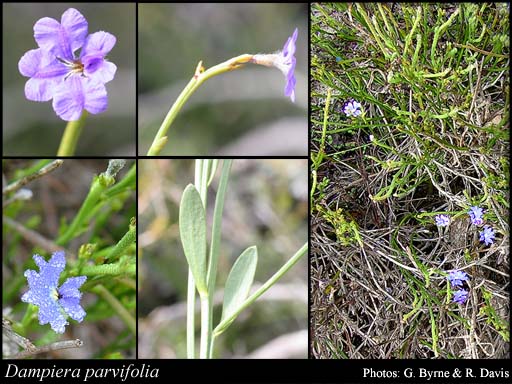- Reference
- Prodr. 589 (1810)
- Conservation Code
- Not threatened
- Naturalised Status
- Native to Western Australia
- Name Status
- Current
Erect, woody perennial, herb, (0.1-)0.2-0.6 m high. Fl. blue-purple, Aug to Dec or Jan to Feb. White sand. Sandplains, gentle slopes.

Scientific Description
Stems ribbed or unribbed. Leaves flat, 10-50 mm long, 2-15 mm wide, Indumentum absent (leaves glabrous); margins entire. Bracteoles absent. Pedicel absent (flowers sessile). Calyx lobes present, Calyx length 4-5 mm long, glabrous. Corolla blue, 7-12 mm long, auriculate, not spurred, hairy on the outside, with dense, simple hairs, glabrous on the inside; central lobes 3.5-5 mm long, with wings; outer lobes 4-6 mm long, wing present on both sides and clearly unequal, 1-1.3 mm wide on the narrower side, 1.2-2 mm wide on the broader side. Anthers connate. Ovary inferior, not gibbose; style 2.5-3.2 mm long, glabrous; indusium single, glabrous; ovules one or two. Flowers in February, August, September, October, November and December. Occurs in the Jarrah Forest (JF), Mallee (MAL) and Esperance Plains (ESP) IBRA Region(s), of the South West (SW) Botanical Province.
Distribution
- IBRA Regions
- Esperance Plains, Mallee.
- IBRA Subregions
- Eastern Mallee, Recherche.
- IMCRA Regions
- WA South Coast.
- Local Government Areas (LGAs)
- Dundas, Esperance, Ravensthorpe.